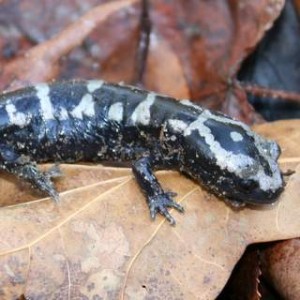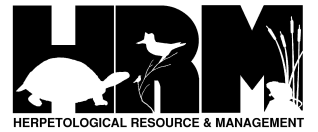Marbled Salamander
Overview:
Scientific Name: Ambystoma opacum
Size: 3.4 – 5” (adult length)
Michigan State Status: Endangered
MDNR Wildlife Action Plan Status: Species of Greatest Conservation Need

Habitat:
Prefer moist lowland forests but also occur in drier woodlands and rocky hillsides.
Adult Coloration:
Body is marked with conspicuous white or gray markings on a black background. Markings usually occur as bands across the head and back and sometimes merge into a stripe down each side of the neck and back. Tail banded with black and white, and belly can be black or dark brown, sometimes with light speckles.
Adult Characteristics:
11-13 costal grooves (grooves between rib-like ridges that run down the sides of the body). Body very stocky. In males the light markings on the body are pure white while in females they are gray (more prominent in breeding season). During breeding males have swollen vents.
Juvenile Characteristics:
Metamorphs are brown or black with light markings that are most dense on head and more scattered on back and tail. Markings may begin yellow and become blue to silvery or white during first few days out of water. Adult pattern develops over several weeks or months.
Larvae Characteristics:
Larvae brown or gray-brown with light spots on sides and tail fins.
Species Confused With:
Small-mouthed Salamanders are slimmer with light markings along sides and no crossbands. Spotted Salamanders have yellow spots that do not merge into stripes down the sides. Tiger Salamanders are considerably larger and have irregular yellow or brownish spots.
References:
- Amphibians and Reptiles of the Great Lakes Region by Jim Harding
- Harding, J.H. and J.A. Holman. 1992. Michigan Frogs, Toads, and Salamanders. MSU Cooperative Extension Service and MSU Museum. Extension Bull. E-2350, 144 pp.
- Ruthven, A. G., H. B. T. Gaige, et al. 1912. The herpetology of Michigan, by Alexander B. Ruthven. Crystal Thompson and Helen Thompson; Memoranda towards a bibliography of the archaeology of Michigan, by Harlan I. Smith; prepared under the direction of Alexander G. Ruthven. Lansing, Mich., Wynkoop Hallenbeck Crawford, State Printers.
- Holman, J. A. 2012. The Amphibians and Reptiles of Michigan: A Quaternary and Recent Faunal Adventure. Detroit, Mich., Wayne State University Press.
- Conant, R., and Collins, J. T. 1998. Reptiles and Amphibians: Eastern, Central North America. Houghton Mifflin Harcourt Press.
Credits:
- ason Poston
